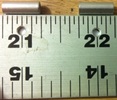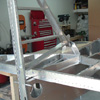


random user submitted photo
AeroInjector Set-up that prevents the "Burps"
Forum rules
Lessons-learned submissions follow a standardized format designed to identify the issue, draw out the relevant factors and present useful guidance to others facing a similar situation. The submitter answers the following 5 questions:
1) What went wrong (or right), and why?
2) What were the shortcomings, and why did they exist?
3) What actions were taken to fix the problem?
4) What preventive actions should be taken into account for future efforts?
5) What overall recommendations should be made for future projects?
The length of the write-up and amount of detail presented are left up to each individual. Some lessons learned can be perfectly conveyed in a few simple sentences, while others will require much more. The goal is to be as clear and succinct as possible, not to generate literary masterpieces!
All posts submitted to this forum are held in a review queue for approval by a moderator. Information in the posts will be reviewed, vetted, and modified as needed before going public. Additionally, any replies that are submitted would also be reviewed to ensure they add value and remain on topic. This will avoid normal threat drift of general discussions.
Lessons-learned submissions follow a standardized format designed to identify the issue, draw out the relevant factors and present useful guidance to others facing a similar situation. The submitter answers the following 5 questions:
1) What went wrong (or right), and why?
2) What were the shortcomings, and why did they exist?
3) What actions were taken to fix the problem?
4) What preventive actions should be taken into account for future efforts?
5) What overall recommendations should be made for future projects?
The length of the write-up and amount of detail presented are left up to each individual. Some lessons learned can be perfectly conveyed in a few simple sentences, while others will require much more. The goal is to be as clear and succinct as possible, not to generate literary masterpieces!
All posts submitted to this forum are held in a review queue for approval by a moderator. Information in the posts will be reviewed, vetted, and modified as needed before going public. Additionally, any replies that are submitted would also be reviewed to ensure they add value and remain on topic. This will avoid normal threat drift of general discussions.
2 posts
• Page 1 of 1
AeroInjector Set-up that prevents the "Burps"
What is a Burp?
The AeroInjector/AeroCarb does not have a float bowl like a traditional carburetor, and can experience a momentary stumble (sometimes called a "burp") under certain circumstances. This stumble is caused by passing a small fuel vapor bubble from the fuel line through the carb and into the intake. The vapor bubble is less dense than a liquid droplet, and this causes the intake mixture to momentarily become overly- lean. The lean condition will persist as long as the fuel line contains bubbles, but will cease when no more bubbles are present. This is fundamentally a fuel delivery issue.
What causes fuel bubbles?
Fuel bubbles are typically caused by two methods: turbulence in the fuel flowing through the fuel line, and fuel vaporization due to excessive heating. Fuel turbulence can be reduced or eliminated by routing the fuel line in a smooth, direct manner; eliminating sharp bends, changes in fuel line internal diameter, unnecessary fitting or elbows; and avoiding "high spots" in the fuel line. High spots will tend to trap bubbles that may be passing through the lines (especially at low fuel-flow conditions), and under certain conditions the trapped accumulated bubbles can break free and enter the carb. This often happens several seconds after a large change in fuel flow, such as advancing the throttle for takeoff.
Fuel vaporization due to heating is typically caused by heat absorption into the fuel line from high under-cowl temperatures, radiated heat from nearby hot engine components that pass close to the fuel line, and several other factors.
High under-cowl temps will cause heat to be conducted through the fuel line and into the fuel contained inside. Reducing under-cowl temps and slowing the rate of heat transfer into the fuel are necessary to prevent excessive fuel heating. An effective technique for insulating fuel lines is to use quality stainless-steel braided fuel lines (as recommended in the AeroInjector User Manual) and then cover the lines with silicon fire-sleeve. Under severe conditions additional insulation may be needed as well, and all fuel system accessories such as the gascolater, fuel flow transducer or hose fittings should also be insulated as well.
Radiated heat from nearby exhaust pipes can quickly heat fuel lines that pass within a few inches of the pipe. Fuel lines should be routed as far from exhaust pipes as practical, and when spacing is insufficient a reflective heat shield can be placed between the fuel line and the exhaust pipe. Other factors that affect fuel vaporization include the density altitude where the engine is operated, the type and quality of fuel (100LL is the most resistant), and the amount of heat-soak that the airplane and fuel have been subjected to.
Operational Considerations
Fuel vaporization is most likely when operating with auto gas/MOGAS (especially "winter" blends of auto fuel or fuel with ethanol), on hot ambient-temperature days, when the plane has been heat-soaked from sitting in the sun or run on the ground with poor cooling such as a long taxi run. These conditions all increase the risk of vaporization, and a cautious operator may decide to postpone operations until the temperatures of the plane and the fuel can be reduced.
Some builders have incorporated additional fuel system plumbing components designed to divert and trap vapor bubbles before they enter the carb. These devices are sometimes called "burp tubes", and function as standpipes or vapor reservoirs. In most cases vapor bubbles can be prevented with proper heat shielding, but in the most severe cases where bubbles are present a burp tube may be effective.
------------
Keywords: AeroCarb AeroInjector, burp, stumble, surge, miss, fuel vaporization, fuel system design, heat shielding, fuel line insulation
The AeroInjector/AeroCarb does not have a float bowl like a traditional carburetor, and can experience a momentary stumble (sometimes called a "burp") under certain circumstances. This stumble is caused by passing a small fuel vapor bubble from the fuel line through the carb and into the intake. The vapor bubble is less dense than a liquid droplet, and this causes the intake mixture to momentarily become overly- lean. The lean condition will persist as long as the fuel line contains bubbles, but will cease when no more bubbles are present. This is fundamentally a fuel delivery issue.
What causes fuel bubbles?
Fuel bubbles are typically caused by two methods: turbulence in the fuel flowing through the fuel line, and fuel vaporization due to excessive heating. Fuel turbulence can be reduced or eliminated by routing the fuel line in a smooth, direct manner; eliminating sharp bends, changes in fuel line internal diameter, unnecessary fitting or elbows; and avoiding "high spots" in the fuel line. High spots will tend to trap bubbles that may be passing through the lines (especially at low fuel-flow conditions), and under certain conditions the trapped accumulated bubbles can break free and enter the carb. This often happens several seconds after a large change in fuel flow, such as advancing the throttle for takeoff.
Fuel vaporization due to heating is typically caused by heat absorption into the fuel line from high under-cowl temperatures, radiated heat from nearby hot engine components that pass close to the fuel line, and several other factors.
High under-cowl temps will cause heat to be conducted through the fuel line and into the fuel contained inside. Reducing under-cowl temps and slowing the rate of heat transfer into the fuel are necessary to prevent excessive fuel heating. An effective technique for insulating fuel lines is to use quality stainless-steel braided fuel lines (as recommended in the AeroInjector User Manual) and then cover the lines with silicon fire-sleeve. Under severe conditions additional insulation may be needed as well, and all fuel system accessories such as the gascolater, fuel flow transducer or hose fittings should also be insulated as well.
Radiated heat from nearby exhaust pipes can quickly heat fuel lines that pass within a few inches of the pipe. Fuel lines should be routed as far from exhaust pipes as practical, and when spacing is insufficient a reflective heat shield can be placed between the fuel line and the exhaust pipe. Other factors that affect fuel vaporization include the density altitude where the engine is operated, the type and quality of fuel (100LL is the most resistant), and the amount of heat-soak that the airplane and fuel have been subjected to.
Operational Considerations
Fuel vaporization is most likely when operating with auto gas/MOGAS (especially "winter" blends of auto fuel or fuel with ethanol), on hot ambient-temperature days, when the plane has been heat-soaked from sitting in the sun or run on the ground with poor cooling such as a long taxi run. These conditions all increase the risk of vaporization, and a cautious operator may decide to postpone operations until the temperatures of the plane and the fuel can be reduced.
Some builders have incorporated additional fuel system plumbing components designed to divert and trap vapor bubbles before they enter the carb. These devices are sometimes called "burp tubes", and function as standpipes or vapor reservoirs. In most cases vapor bubbles can be prevented with proper heat shielding, but in the most severe cases where bubbles are present a burp tube may be effective.
------------
Keywords: AeroCarb AeroInjector, burp, stumble, surge, miss, fuel vaporization, fuel system design, heat shielding, fuel line insulation
- sonex1374
- Posts: 605
- Joined: Thu Mar 27, 2014 1:02 am
Re: AeroInjector Set-up that prevents the "Burps"
One more factor not mentioned is to not use the ACS gascolator (#10580) in your fuel delivery system. On the first test flight of my Sonex, now 15 years ago, during a sustained climb, my 3300 engine more than burped........it coughed. That is to say, the engine "died" for a second before continuing on. All of the measures to prevent vapor lock had been accomplished, including building a shroud around the gascolator to which a cold air blast tube was attached. The engine continued to cough once or twice during any sustained climb.
In discussing this matter with the Sonex factory, Kerry indicated that other builders had used the Usher gascolator with apparent success. So, ultimately I switched to the blue Usher gascolator and the "cough" went away, never to return. I never learned what was unique regarding the ACS gascolator to cause the cough or what is unique regarding the Usher gascolator to not cause a cough. Both have similarly sized screens. I had attempted to polish the ports of the ACS gascolator to reduce the pressure drop through it, but this was of no help.
Art,,,,,,,,,,,,,,,,,,,,Sonex taildragger #95,,,,,,,,,,,,,,,,,,,Jabiru 3300 #261
In discussing this matter with the Sonex factory, Kerry indicated that other builders had used the Usher gascolator with apparent success. So, ultimately I switched to the blue Usher gascolator and the "cough" went away, never to return. I never learned what was unique regarding the ACS gascolator to cause the cough or what is unique regarding the Usher gascolator to not cause a cough. Both have similarly sized screens. I had attempted to polish the ports of the ACS gascolator to reduce the pressure drop through it, but this was of no help.
Art,,,,,,,,,,,,,,,,,,,,Sonex taildragger #95,,,,,,,,,,,,,,,,,,,Jabiru 3300 #261
- builderflyer
- Posts: 441
- Joined: Sat Jul 09, 2016 12:13 pm
2 posts
• Page 1 of 1
Who is online
Users browsing this forum: No registered users and 4 guests







